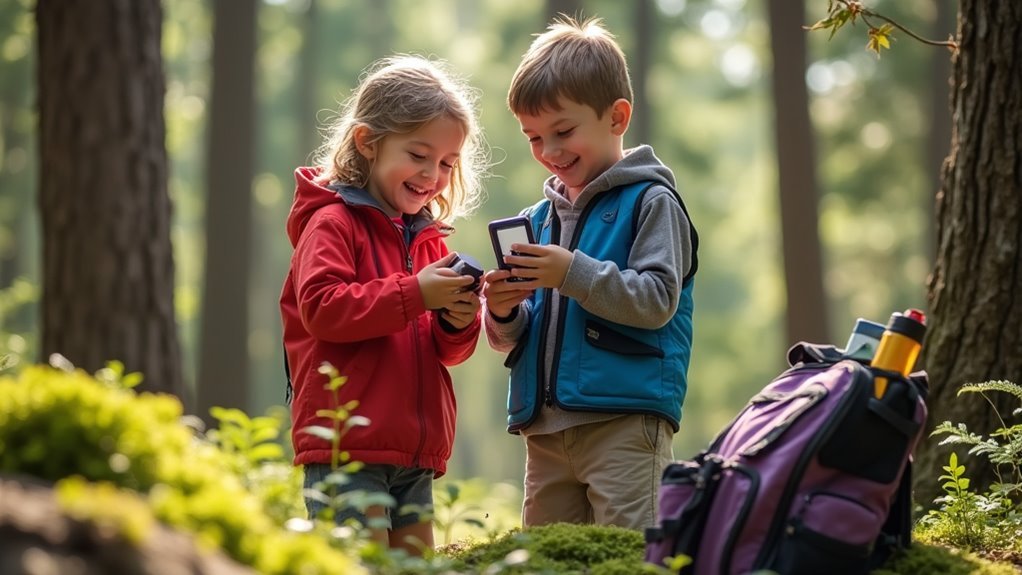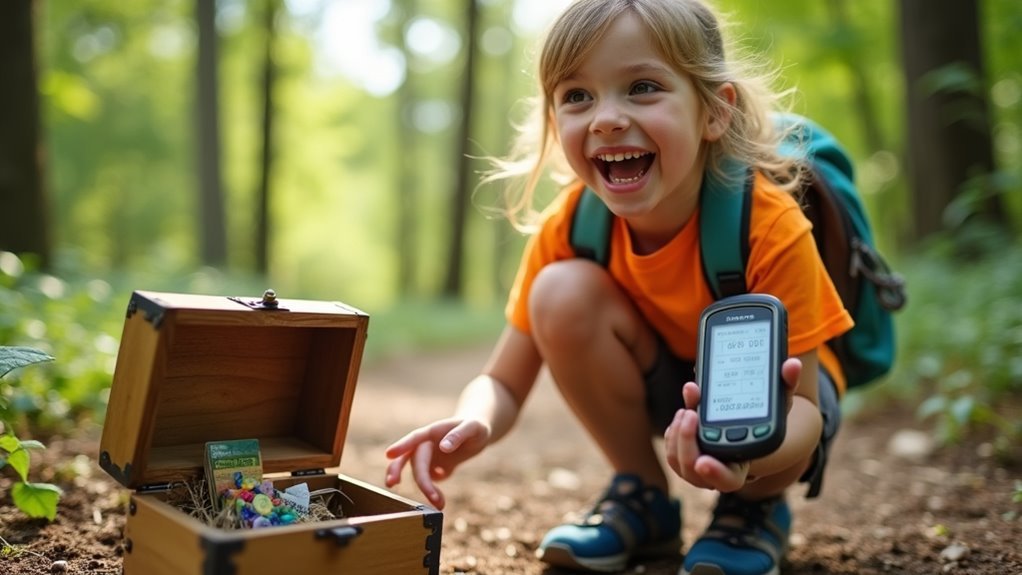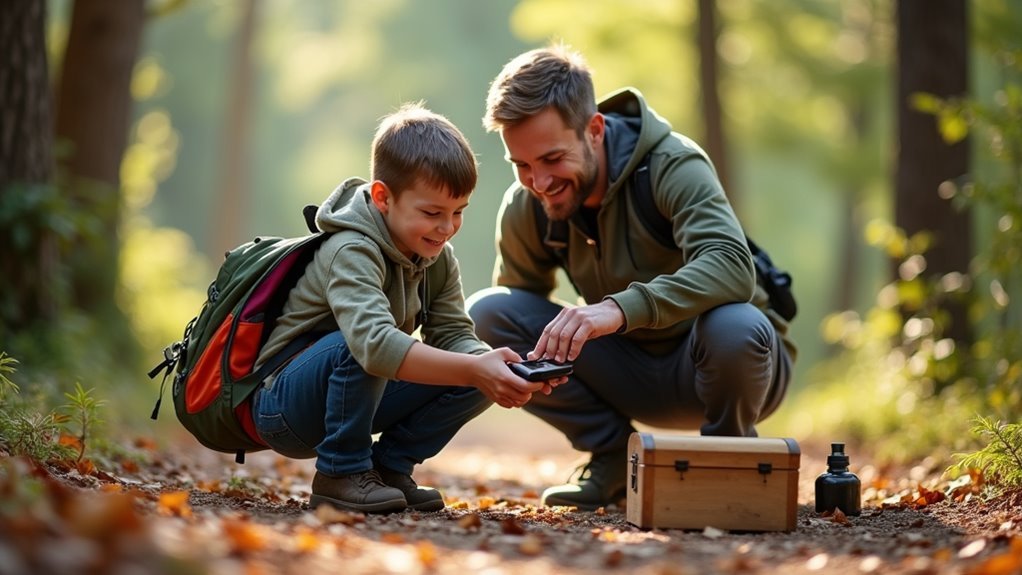Some of the links in this article may be affiliate links. If you make a purchase through these links, we may earn a small commission at no extra cost to you. Thank you.
Did you know the ancient art of treasure hunting has gone digital? I’ve found geocaching to be one of the most natural ways to teach kids GPS skills without them even realizing they’re learning. When I first introduced my nephew to his first cache hunt, his eyes lit up not at the technology in his hands, but at the possibility of discovering something hidden just steps away. The beauty lies in how it transforms ordinary walks into extraordinary adventures—and I’m about to show you how.
What Makes GPS Technology Perfect for Young Explorers

Why is GPS technology such a hit with kids?
I’ve found that in geocaching with kids, it’s the perfect blend of digital engagement and outdoor adventure.
Geocaching bridges the digital world kids love with the outdoor exploration they need—technology that takes adventures beyond the screen.
Most youngsters can quickly grasp how to use a GPS device or app—especially since the interface shows them exactly where to go with those intuitive red lines.
When I take my nieces out, they love that GPS technology gets them within 30 feet of hidden treasures without needing complex navigation skills.
It’s like giving them a digital superpower!
The fact that they can use the same smartphone they’re already familiar with makes geocaching even more accessible.
I think this low barrier to entry is why so many families are turning to geocaching as their go-to weekend activity—it’s technology that actually gets kids outside rather than keeping them in.
Selecting Kid-Friendly GPS Devices and Apps
When I started teaching my kids to geocache, I found that smartphones are actually the easiest GPS option since they don’t require learning complicated separate devices.
The free Geocaching app is perfect for beginners, limiting access to only the simplest caches rated 1.5 and below, which helps kids build confidence without getting frustrated.
As your young explorers gain experience, you might consider the $30 annual premium membership that provides access to more challenging caches, letting you gradually increase difficulty as their skills improve.
Kid-Friendly Device Options
Finding the right GPS device for your kid can be a game-changer when teaching navigation skills.
I’ve found that smartphones are actually the easiest way to get kids started geocaching.
They’re intuitive, and the free Geocaching app limits searches to caches with lower difficulty and terrain ratings that are easy to find.
When selecting a device to navigate to a specific cache, consider these options:
- Smartphone with free Geocaching app – Perfect for beginners, showing only caches rated 1.5 or below
- Premium membership ($30/year) – Worth it once your child masters the basics and wants more challenges
- Traditional GPS units – Still usable but honestly, they’re clunkier and less kid-friendly than modern apps
Most kids pick up smartphone navigation incredibly quickly, which makes the whole experience more enjoyable for everyone.
Simplifying GPS Interfaces
Simplicity is the secret sauce when introducing kids to GPS technology. I’ve found that the Geocaching app is perfect for beginners since it transforms complex coordinates into friendly green dots on a map. Kids don’t need to understand all the technical stuff to find their first cache!
What I love about using smartphone apps instead of dedicated devices is that children already know how to use touchscreens.
The free version of the Geocaching app is actually ideal for starting out—it limits you to easier caches rated 1.5 or below, which means less frustration for young explorers learning to navigate.
If your kids really take to geocaching, the $30 yearly premium membership might be worth it. It opens up more caches to find while still keeping the interface simple enough for little hands.
Apps for Young Explorers
The world of GPS apps for kids expands way beyond just the Geocaching app I mentioned earlier.
I’ve found that the best apps combine Outdoor Adventure with user-friendly interfaces that help children find a cache without frustration.
When Participants navigate using these tools, they’re building confidence while having fun.
Here are my top recommendations:
- Geocaching App (Free Version) – Perfect for beginners with access to caches rated 1.5 or below, requiring just a smartphone and free account
- Compass View Features – Look for apps with the red line guidance system to help kids attempt coordinates without getting lost
- Safety-Focused Options – Choose apps that encourage awareness of surroundings while exploring, making outdoor adventures both fun and safe
Starting Small: Backyard GPS Navigation Games
Introducing your kids to GPS technology doesn’t require venturing into unknown territories right away.
I’ve found that my own backyard makes the perfect training ground for little explorers.
Using the free Geocaching app, I hide small containers—simple “caches”—around familiar spaces and mark their coordinates.
The app’s compass feature is accurate to about 30 feet, making it perfect for a backyard treasure hunt.
What I love is how quickly kids grasp the concept when they’re searching for something tangible.
To find the geocache, they’ll use directional cues and the map view for guidance.
You know what works really well?
Rating these outdoor treasure challenges as difficulty level 1, then gradually increasing complexity as their confidence grows.
They’re learning navigation skills without even realizing it!
Understanding Coordinates: Making Math Fun Through Geocaching

I’ve found that geocaching transforms boring coordinate numbers into exciting treasure maps for kids who might otherwise tune out math lessons.
When I take my niece geocaching, we talk about how latitude lines run east-west (like the rungs on a ladder climbing north) while longitude lines run north-south, creating a giant grid across our planet.
You’ll be amazed at how quickly children grasp these concepts when there’s actual treasure waiting to be found at N 40° 15.123 W 111° 42.456!
Coordinates as Treasure Maps
Have you ever thought about how pirates used treasure maps to find buried gold?
Well, modern treasure hunting uses GPS coordinates instead of faded parchment!
I’ve found that kids absolutely light up when they realize those numbers actually lead to a real geocache (container) hidden somewhere nearby.
Here’s why coordinates make perfect treasure maps for geocache hunts:
- They’re incredibly precise – that original cache from 2000 in Oregon at 45.5189° N, 122.6803° W is still found using the exact same numbers
- They apply math in a fun, tangible way – kids practice real skills while playing a hunting game
- They build confidence gradually – starting with 1-star caches means immediate success for beginners
I’ve seen children improve their mapping skills by 25% just by regularly participating in these adventures!
Latitude vs. Longitude Basics
When you’re teaching kids about GPS coordinates, the very first puzzle they need to solve is understanding the difference between latitude and longitude. I’ve found that comparing latitude lines to the rungs of a ladder works really well – they run horizontally around Earth, measuring north-south positions from the equator (0°).
Longitude lines, on the other hand, run vertically like the seams of a basketball, measuring east-west positions from the Prime Meridian.
In geocaching, these coordinates combine (like 37°47.123’N, 122°25.456’W) to create a unique address for each cache.
I think this makes math suddenly relevant – kids who struggle with numbers in class become enthusiastic mathematicians when those digits lead to hidden treasure!
Plus, it’s amazing to see them realize that latitude affects climate while longitude determines time zones.
Safety First: Teaching Responsible Navigation Skills
Why should safety be our first priority when teaching kids to use GPS technology?
When we introduce children to the exciting world of geocaching, we must balance adventure with protection.
I’ve found that kids get so caught up in the thrill of the hunt they might forget basic safety awareness.
Here are my top safety tips for young geocachers:
- Always check hiding spots for potential dangers like poison ivy or unstable rocks before reaching in
- Practice Leave No Trace principles and CITO (Cache In Trash Out) by replacing everything exactly as found
- Teach kids to monitor their surroundings while using GPS, not just their screens
In my experience, starting with 1-star difficulty caches builds confidence while keeping kids in safer areas.
From Beginners to Pros: Age-Appropriate GPS Challenges

How do you match GPS challenges to a child’s developmental stage?
Well, I’ve found that cache types and sizes make all the difference.
For kids 5-7, I recommend starting with larger caches at 1-star difficulty—they’re easier to spot and build confidence.
The size of the cache matters a lot; traditional caches work best for little hands!
Kids 8-12 can handle 1.5 difficulty ratings on the free app, while teens can tackle those tricky micro caches with premium membership ($30/year).
When my daughter got frustrated, the geocaching help center offered great tips.
Don’t forget about CITO (Cache In Trash Out) events—they’re perfect for teaching environmental stewardship while hunting.
I think it’s one of the best ways to connect GPS skills with real-world responsibility.
Turning Technology Struggles Into Learning Moments
The frustrating moment when your GPS arrow spins in circles or jumps locations isn’t just a tech headache—it’s actually a golden teaching opportunity!
I’ve watched kids’ first time geocaching attempts transform from confusion to confidence with a little patience.
When technology challenges arise, try these approaches:
- Have kids practice a little CITO (Cache In, Trash Out) while they’re figuring out the GPS—environmental awareness becomes part of the navigation lesson
- Use the free geocaching app’s red line feature to simplify direction finding
- Turn coordinate confusion into math lessons by plotting latitude/longitude together
I’ve found that kids who initially struggle with GPS settings are often more persistent when they’re finally able to find their cache.
Each attempt to find becomes a mini problem-solving adventure!
Building Confidence Through Progressive GPS Adventures
After seeing kids overcome GPS glitches, I’ve learned that true navigation confidence comes from a step-by-step approach.
Building navigation confidence isn’t about perfect technology—it’s about gradually developing skills through real-world challenges.
I always start my children with simple 1-1.5 difficulty geocaches using the free app, which has led us to discover new parks we never knew existed.
Once they master the basics, we tackle caches with 2-3 ratings.
My son was so proud when he completed his first long hike to a slightly challenging cache!
We track progress on Geocaching.com, reviewing each find before planning the next one.
Puzzle caches have been a good time for developing problem-solving skills.
I think—actually, I know—the shift from map view to compass navigation builds serious confidence.
Kids naturally progress from “Is this right?” to “I know exactly where we need to go!”
Combining Digital Skills With Nature Appreciation
While exploring nature with a GPS in hand, I’ve discovered that digital navigation and outdoor appreciation aren’t competing interests—they’re perfect companions.
When kids participate in geocaching, they’re not just learning coordinates—they’re connecting with the history of your area through hidden caches that highlight local landmarks.
Here are three ways I combine technology with nature appreciation:
- Encourage kids to bring trinkets for trade and leave something of equal value, teaching both digital etiquette and environmental respect
- Participate in CITO (Cache In Trash Out) events where we clean up trails while hunting treasures
- Use cache finds as opportunities to discuss local plants and wildlife you encounter along the way
I’ve found that trade items become conversation starters about both technology and nature—making the digital-outdoor connection seamless and meaningful.
Frequently Asked Questions
How to Do Geocaching With Kids?
I’ve led MILLIONS of kid-friendly geocaching hunts! Download the app, choose simple caches, tell adventure stories during nature exploration, give creative hints when needed, and use reward systems for successful finds.
Is Geocaching Ok for Kids?
Yes, geocaching is great for kids! I’ve found it combines educational value with fun. Just make sure parental guidance, watch for weather risks, and have fun alternatives ready if needed for child safety.
Does Geocaching Use GPS?
No, geocaching uses carrier pigeons—kidding! I’m relying entirely on GPS Evolution and Satellite Signals. Your device’s compatibility matters when receiving coordinates through Navigation Techniques, though Signal Interference can sometimes challenge accuracy outdoors.
What Are the Three Main Rules of Geocaching?
I’d say the three main rules are: trade items fairly (Cache Etiquette), always sign the logbook (Logbook Protocol), and leave everything as you found it (Environmental Rules). Be discreet when searching!